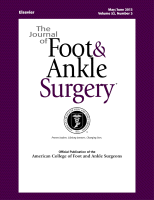
FOOT & ANKLE
Examining efficacy of a dual-component IM implant versus K-wire in hammer toe arthrodesis
J Foot Ankle Surg. 2016 Jul-Aug;55(4):697-708.91 patients (95 toes) with unilateral hammertoe deformity were randomized to undergo arthrodesis with either a dual-component intramedullary stainless steel (DCIMSS) implant or K-wire fixation. The purpose of this study was to determine if the use of a DCIMSS implant resulted in a significantly improved rate of successful arthrodesis (radiographic fusion), patient-reported pain, function, disability, activity level, and a lower incidence of complications when compared to K-wire fixation over a 6-month follow-up period. A significantly higher incidence of successful union was observed from 6 weeks to 6 months with the DCIMSS implant compared to K-wire fixation. No statistically significant differences between groups were noted in either Bristol Foot Scores or Foot Function Index scores, with the exception of a significantly lower mean BFS in the DCIMSS group versus the K-wire group at 1 week postoperatively.
Unlock the full ACE Report
You have access to {0} free articles per month.Click below to unlock and view this {1}
Unlock NowCritical appraisals of the latest, high-impact randomized controlled trials and systematic reviews in orthopaedics
Access to OrthoEvidence podcast content, including collaborations with the Journal of Bone and Joint Surgery, interviews with internationally recognized surgeons, and roundtable discussions on orthopaedic news and topics
Subscription to The Pulse, a twice-weekly evidence-based newsletter designed to help you make better clinical decisions
Exclusive access to original content articles, including in-house systematic reviews, and articles on health research methods and hot orthopaedic topics
Or upgrade today and gain access to all OrthoEvidence content for just $1.99 per week.
Already have an account? Log in


Subscribe to "The Pulse"
Evidence-Based Orthopaedics direct to your inbox.
{0} of {1} free articles
Become an OrthoEvidence Premium Member. Expand your perspective with high-quality evidence.
Upgrade Now












































































